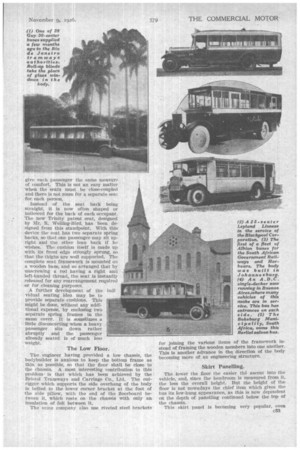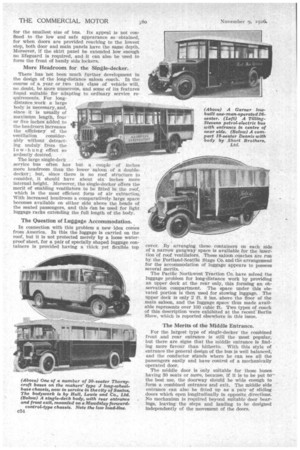THE TREND OF MODERN BUS-BODY DESIGN.
Page 114

Page 115

Page 116

If you've noticed an error in this article please click here to report it so we can fix it.
• There is a Brisk Demand for New Buses to .Replace Those of Older Pattern, to Augment Existing Fleets and to Run on Fresh Routes.
S0 far as the single-deck bus is concerned, the design of the body continues to follow the lines of the private saloon, even for service work. More refinement and comfort are the order of the day, and how to reconcile this ideal with. a reasonable capital outlay and low maintenance cost is the problem which the bus proprietor is attempting to solve in consultawith the bodybuilder.
Both are eager that improvements shall be effected and that there shall be no stagnation in design. The owner of the more luxurious vehicle, however, cannot as a rule raise the fare tariff, whilst, on the other jiand, the bodybuilder finds it very difficult to keep on adding refinements without increasing the cost of production. •
The Importance of Standardization.
The solution lies in paying more attention to standardization and to the use of such new devices and methods of construction, of which simplicity is the keynote, as entailing no increase, in labour costs. Standardization is being introduced so far as the varying requirements of different localities allow, and the bus proprietor can do his share in this good work by not insisting too much upon modifications from what is offered to him as a typical high-class body having the seating capacity, and style of entrance he desires.
The bodybuilder who has the responsibility of deciding what shall constitute a good standard model should be able to satisfy the majority of his customers if he studies his market carefully and keeps in touch with every step made in the progress of the industry.
The bus, bodybuilder recognizes the extravagance of building a fresh design for each customer, and a large number of companies has proved the economy of keeping to a standard turnunder and a sectional' shape of pillar so far as possible and following a general constructional arrangement so that it can be readily adapted to either a front or a rear-entrance body.
The Merits of Steel Construction.
Some more experiments have been made in connection with the substitution of steel for wood in the framework of the body. Those who examined the allsteel private bodywork at the Motor Show at Olym p24 pia last month will need no convincing as to the possibilities of this method of construction.
It is argued that the cost of the necessary dies would be prohibitive, but if two or three types of side pillar, the same number of hoop-stick bends and rounded hind corner frames could be produced in large quantities, together with one or two varieties of bracket and straight sections available in different lengths for cutting up as required, even the smallest firm could participate in this method of building from ready-made component parts.
A Plea for Chassis Standardization.
The bodybuilding industry wOuld welcome an agree meat amongst motor manufacturers as to the leading dimensions of the chassis such as affect the design of the body. New models of chassis are continually being brought forward with a low loading-line, some with normal and others with forward steering, and yet another class is the six-wheeler. It would appear, therefore, that the present time is not propitious for the question of standardization to be brought forward, but it is a matter which should not be lost sight of when the engineer is chiefly concerned with the improvement of minor details and not with revolution
• The Economy of a Wide Range of Readymade Fittings.
Another factor which helps the bodybuilder to produce high-class bodies economically is the opportunity.-,'I for buying a wide range of up-to-date _fittings rathe'r than having to make them himself. The bodybuilder must be in a very large way of business, , With little variation in the class of work done, font to be worth while to design and manufacture his own door and window furniture, windscreens, handles and similar items.
Those accessory manufacturers which specialize in bus fittings have already placed within reach of the trade a wide selection of fittings which are continually being improved, but the range available should be capable of further extension, with a corresponding advantage in economy of manufacture and in scope for variation in design.
Attention to Individual Seating.
Much attention is still being paid to the improvement of the garden chair or seat which accommodates two passengers. The main object in view is to
give each passenger the same measure of comfort. This is not an easy matter • when the seats must be close-coupled and there is not room for a separate seat for, each person.
Instead of the seat back being straight, it is now often shaped or hollowed for the back of each occupant. The new Trinity patent seat, designed by Mr. R. Welling-Bird, has been de
signed from this standpoint. With this•device the seat has two separate spring backs, so that one passenger may sit upright and the other lean back if he wishes. The cushion itself is made up with its front edge strongly sprung, so that the thighs are well supported. The complete seat framework is mounted on a wooden base, and so arranged that by unscrewing a rod having a right and left-handed thread, the seat is instantly released for any rearrangement required or for cleaning purposes.
A further development of the "ndi vidual seating idea may be to provide separate cushions. This might be done, without any additional expense, by enclosing two separate spring frames in the same cover. It is sometimes a little disconcerting when a heavy passenger sits down rather abruptly and the passenger already seated is of much less weight
The Low Floor.
The engineer having provided a low chassis, the bodybuilder is anxious to keep the bottom frame as thin as possible, so that the floor shall be close to the chassis. A most interesting contribution to this problemis that which has been achieved by the Bristol Tramways and Carriage Co., Ltd. The outrigger which supports the side overhang of the body is bolted to the lower corner bracket at the foot of the side pillow, with the end of the floorboard between it, which rests on the chassis with only an insulation of felt between It.
The same company also use riveted steel brackets for Joining the various items of the framework instead of framing the wooden members into one another. This is another advance in the direction of the body becoming more of an engineering structure.
Skirt Panelling.
The lower the floor the easier the ascent into the vehicle, and, since the headroom is measured from it, the less the overall height. But the height of the floor is not nowadays the chief item which gives the bus its low-hung appearance, as this is now dependent on the depth of panelling continued below the top of the chassis.
This skirt panel is becoming very popular, even c33 for the smallest size of bus. Its appeal is not confined to the low and safe appearance so obtained, for when doors are provided reaching to the lowest step, both door and main panels have the same depth. Moreover, if the skirt panel be extended low enough no lifeguard is required, and it can also be used to form the front of handy side lockers.
More Headroom for the Single-decker.
There has not been much further development in the design of the long-distance saloon coach. In the course of a year or two this class of vehicle will, no ,doubt, be more numerous, and some of its features found suitable for adapting to ordinary service requirements. For longdistance work a large body is necessary, and, since it is usually of maximuni length, four or five inches added to the headroom increases the efficiency of the
ventilation considerably without detracting unduly from the low-hung effect so ardently desired.
The large single-deck service bus often has but a couple of inches more headroom than the lower ' saloon of a doubledecker ; but, since there is no roof structure to consider, it should have about six inches more internal height. Moreover, the single-decker offers the merit of enabling ventilators to be fitted in the roof, which is the most efficient form of air extraction. With increased headroom a comparatively large space becomes available on either side above the heads of the seated passengers, and this Can be used for light luggage racks extending the full length of the body.
The Question of Luggage Accommodation.
In connection with this problem a new idea conies from America. In this the luggage is carried on the roof, but it is not protected merely by a loose waterproof sheet, for a pair of specially shaped luggage containers is provided having a thick yet flexible top
cover. By arranging these containers on each side of a narrow gangway space is available for the insertion of roof ventilators. These saloon coaches are run by the Portland-Seattle Stage Co. and the arrangement for the accommodation of luggage appears to possess several merits.
The Pacific Northwest Traction Co. have solved the luggage problem for long-distance work by providing an upper deck at the rear only, this forming an observation compartment. The space under this elevated portion is then used for stowing luggage. The upper deck is only 2 ft. 8 ins, above the floor of the .main saloon, and the luggage space thus made available represents over 100 cubic ft. Two types of coach of this description were exhibited at the recent-Berlin Show, which is reported elsewhere in this issue.
The Merits of the Middle Entrance.
For the largest type of single-decker the combined front and rear entrance is still the most popular, but there are signs that the middle entrance is finding more favour than hitherto. With this style of • entrance the general design of the bus is well balanced, and the conductor stands where he can see all the passengers easily and have control of a mechanically operated door.
The middle door is only suitable for those buses having 30 seats or more, because, if it is to be put to the best use, the doorway should be wide enough to form a combined entrance and exit. The middle side entrance can also be fitted up as a pair of sliding doors which open longitudinally in opposite directions. No mechanism is required beyond suitable door hearings, leaving the steps and landing to be designed independently of the movement of the doors.












































































































































































































